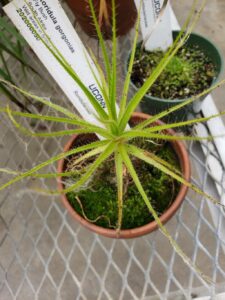How to Propagate Roridula gorgonias

Taming the Flytrap That’s Not a Flytrap: Propagating Roridula gorgonias
The plant world is full of surprises, and few are as captivating yet perplexing as Roridula gorgonias. This stunning South African native might resemble a sundew with its glistening, sticky tentacles, but it’s not trapping insects for a tasty meal. It’s cultivating a bizarre partnership – and learning to propagate this unique species means stepping into the fascinating world of symbiotic relationships.
More than Meets the Eye: Understanding Roridula
Roridula gorgonias isn’t your typical carnivorous plant. While its sticky resin traps insects just like its sundew cousins, it lacks the digestive enzymes to break down its prey. Instead, it relies on a fascinating partnership with a tiny assassin bug, Pameridea roridulae. This bug is immune to the plant’s sticky trap and feasts on the captured insects. In return, its droppings provide the Roridula with essential nutrients.
Propagation: A Balancing Act
Propagating Roridula gorgonias can be achieved through two primary methods:
1. Seed Propagation:
- Obtain seeds: Sourcing seeds might be challenging as they are not readily available commercially. Look for reputable carnivorous plant nurseries or online communities specializing in unusual species.
- Mimic nature: Roridula seeds require a period of cold stratification to break dormancy. Sow the seeds on the surface of a moist, acidic growing medium (a peat moss and perlite mix works well) and place them in a refrigerator for around 6-8 weeks.
- Patience is key: After stratification, move the pots to a bright location but out of direct sunlight. Germination can be slow and sporadic, taking several weeks to months.
- Don’t forget the bugs!: If you’re fortunate enough to have access to Pameridea roridulae, introducing a few to your seedlings once they are established will greatly benefit their growth.
2. Cuttings:
- Choose wisely: Select healthy, non-flowering stems for cuttings. The best time for taking cuttings is during the active growing season in spring or early summer.
- Careful cutting: Using a sterile blade, cut a 3-4 inch section of stem just below a leaf node. Remove the lower leaves, leaving only a couple at the top.
- Hormone boost: While not essential, dipping the cut end in rooting hormone can improve the success rate.
- Create a humid environment: Plant cuttings in the same acidic growing medium used for seeds. Cover the pot with a clear plastic bag or humidity dome to maintain moisture around the cutting.
- Monitor closely: Keep the cuttings in a bright location but away from direct sunlight. Root development can take several weeks. Once new growth appears, you can gradually acclimate the plant to lower humidity.
Challenges and Rewards
Propagating Roridula gorgonias requires patience and a touch of green thumb magic. Maintaining the plant’s symbiotic relationship with Pameridea roridulae is crucial for its long-term health and vigor. However, the reward of successfully cultivating this fascinating and unusual species is well worth the effort. Having a Roridula gorgonias in your plant collection means owning a living testament to the intricate web of life and the wonders of symbiotic partnerships in the natural world.